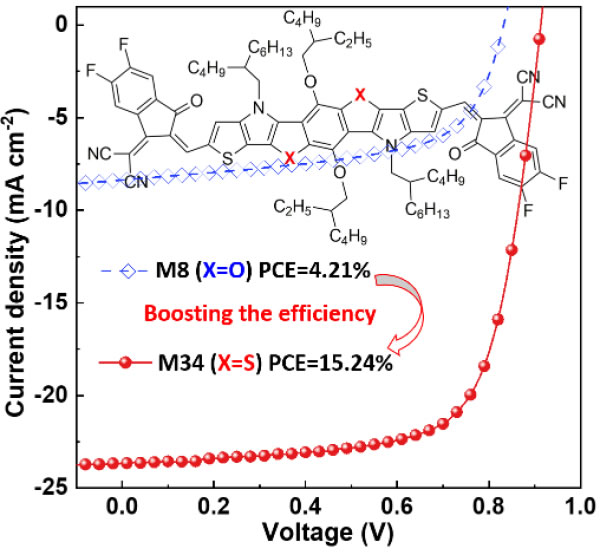Non-fullerene acceptor materials have the advantages of simple synthesis, easier adjustment of energy level and band gap, and good morphology stability, so they have attracted more and more attention. Among several different types of acceptor materials, the study of acceptor-donor-acceptor (ADA) as a bone framework type of small molecule acceptor materials is relatively extensive. In recent years, thanks to the development of many ADA-type non-fullerene acceptor materials, the photoelectric conversion efficiency of organic solar cells has made progress. At present, most of the ADA-type non-fullerene acceptor materials require sp3 hybridized bridging carbon atoms. This is because the alkyl side chain (or aryl alkyl side chain) on the bridging carbon atom can effectively reduce the excess of material molecules. The aggregation also improves the solubility of the material. However, these side chains extending out of the plane of the conjugated framework will destroy the close-packing between the molecules of the acceptor material, thereby affecting its charge transport and further improvement of photovoltaic performance. In response to the above problems, Zheng Qingdong, a researcher at the State Key Laboratory of Structural Chemistry, Fujian Institute of the Structure of Matter, Chinese Academy of Sciences, developed a non-fullerene receptor material system with no sp3 carbon on the conjugated skeleton and proposed the use of "orthogonal side chains" The steric hindrance effect to inhibit the excessive aggregation of receptor material molecules. At the same time, the researchers realized the regulation of the energy level, band gap and molecular orientation of the target acceptor material by optimizing the aromaticity of the trapezoidal fused ring, which improved the charge transport and photovoltaic performance of the material. The photoelectric conversion efficiency of the optimal polymer solar cell optimized by the device reaches 15.24%. This research has developed a high-mobility non-fullerene acceptor material without sp3 bridging carbon with suitable band gap and aggregation properties, and demonstrated that the aromaticity of the trapezoidal fused ring has an effect on the band gap, energy level, molecular orientation, charge transport and The influence of photovoltaic performance provides a new strategy for the design and synthesis of new non-fullerene acceptor materials. Recently, related research results were published in "Germany Applied Chemistry". The first author of the paper is Ma Yunlong, an associate researcher of the research team. The research work is supported by the key projects of the National Natural Science Foundation of China Strait Joint Fund, the Strategic Leading Science and Technology Special Project of the Chinese Academy of Sciences, and the Natural Science Foundation of Fujian Province. Previously, the research team has made a series of research progress in the design and synthesis of non-fullerene acceptor materials and device preparation. The relevant results have been published in (Materials Horizons 2020, 7, 117; Chemistry of Materials 2017, 29, 7942; Chemistry) of Materials 2017, 29, 9775; Chemistry of Materials 2019, 31, 5953; Journal of Materials Chemistry A 2019, 7, 9609). PP Nonwoven Fabric,High Quality PP Nonwoven Fabric,PP Nonwoven Fabric Details, CN Dongguan Huitong Automatic Machinery Technology Co., Ltd , https://www.breezesolution.com
Molecular structure and photovoltaic performance of ADA acceptor materials